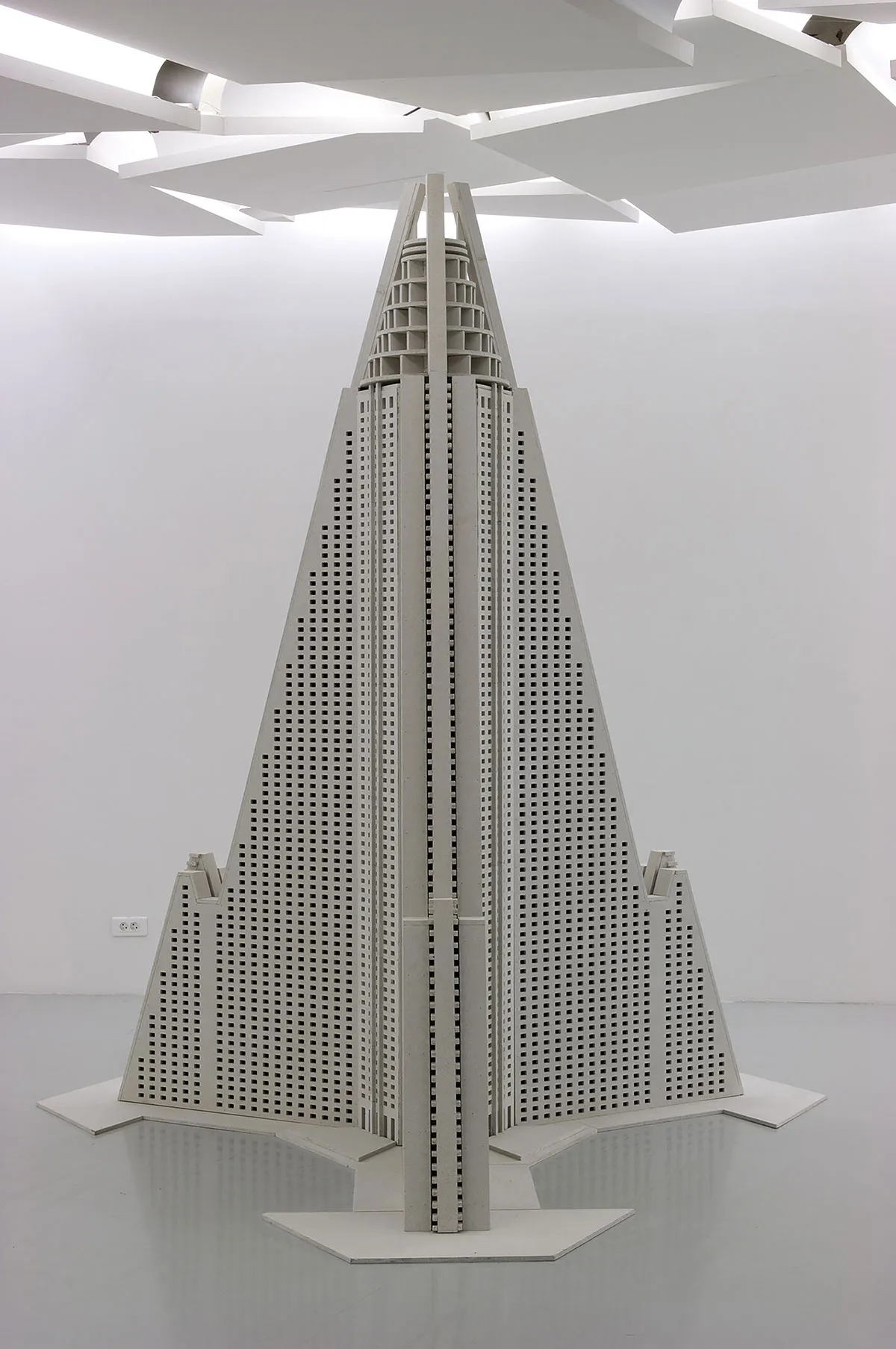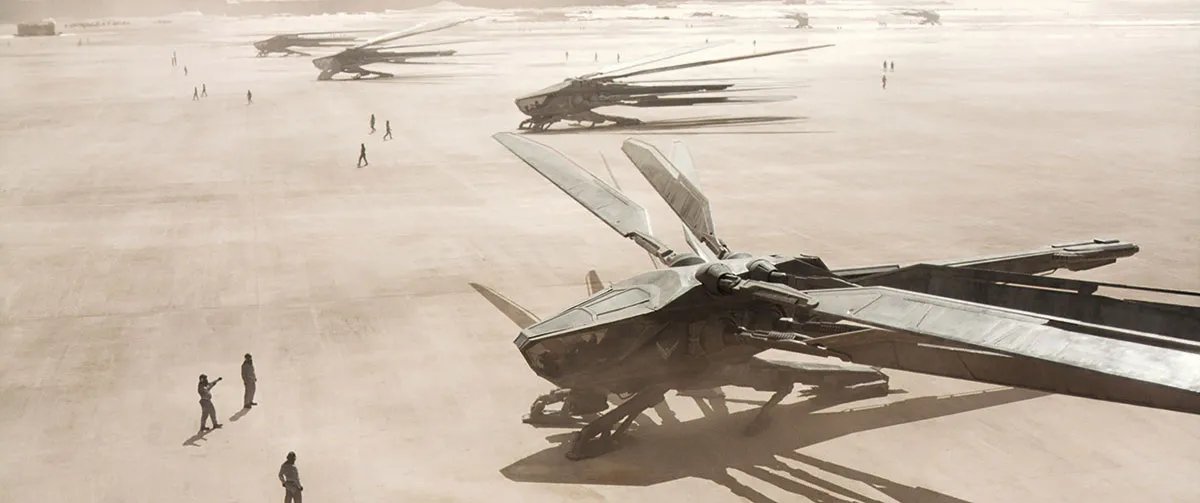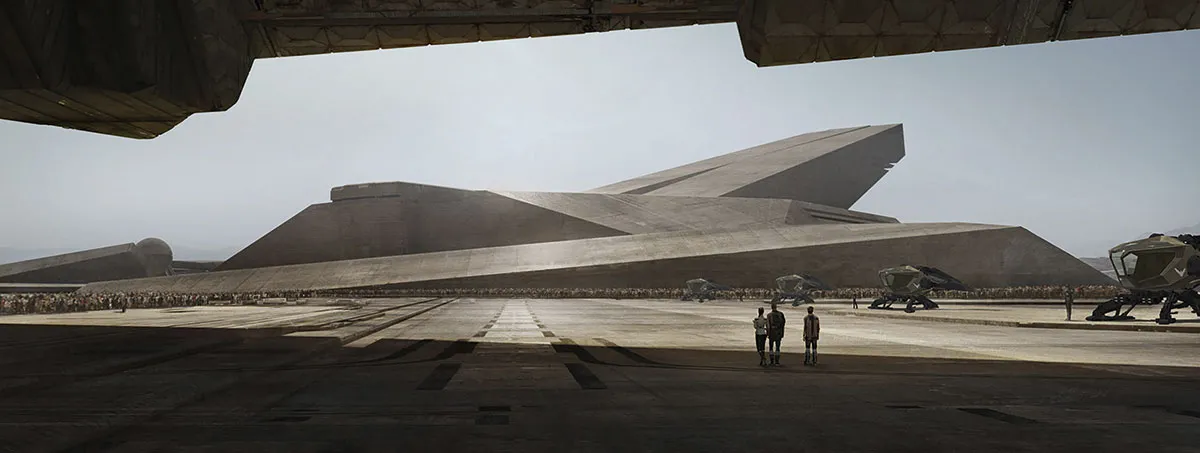As the film’s production designer, Patrice Vermette is responsible for the look and feel of Dune, building the world that the characters move through. He speaks to Daniel Bennett about how you create a sci-fi world from the pages of a book.
Where do you start with a fictional Universe as big as Dune?

It could have been overwhelming. But I always look for the angle of attack. It’s like going skiing. You can see the slope: it’s very, very steep and you could either decide to go straight down, or you can slalom down.
If you’ve read the books, you’ll know there’s enough description to point you in a good direction, but then again it doesn’t dictate what the world should be, so you can make it your own.
I started collecting images from research, illustrations from books, the internet, little scamps and so on. From there, I exchanged with Denis [Villeneuve, the director], and we played tennis with our ideas.
Once we found the right tone we started drawing and then hired some concept artists who worked off the reference boards. These mood boards give us the tonality of where we want to go architecturally and in terms of scale. It can be an extremely bizarre collection of images sometimes. So we start off very wide and then we will zoom in to the finer details.
It’s great to work with Denis because once he agrees on something he likes, he never changes his mind, he’ll never go back. You’re certain you can keep digging in a direction and that will be the right direction. That allows us to go deeper and deeper into the design, we’ll never have to reinvent anything.
So what would we find on the Dune mood boards?
The first thing I remember Denis showing me was a board of Richard Avedon photography, which was great for the softness of the mood. And we shared images of bunkers from WWII; images of ziggurat architecture from Mesopotamia; brutalist architecture from the ex-Soviet bloc and also Brazilian brutalist architecture. That was for Arrakeen [the main city in Arrakis, the planet on which Dune is mostly set].
We talked about how the colonialism always tries to force itself onto a landscape, which led me to the work of Nicolas Moulin and of Super Studio in the 1960s, both concept architects who had these designs for huge human-made constructions jutting out of landscapes, which were kind of terrifying. I think that imagery resonated in what we wanted to create in the world of Dune: the sense of scale, and a sense of imposing yourself on a place, and the idea that these structures can show the power of a nation. That was very important for us.
After that we started thinking about the landscape itself, and the natural elements of each planet in the book. Arrakis has winds of up to 850 km/h (530mph) that would tear the pavement off the ground. So, I try to think like an architect or a city planner building this place. Oh yeah, and there’s this big worm…
You have to be true to the nature of things, the elements of the planet. So I would start by setting the foundation of a city on Arrakis in a natural protective environment, which would probably be a mountain bowl. There you have protection from the wind, and the rocks would stop the worm from penetrating. And then you create very angular structures so the wind can just slip past the structure as opposed to smashing right into these buildings.
The weather was another thing that stuck from the beginning. Both Denis and I are French Canadian and fall [autumn] is our favourite season. It’s not too warm, it’s not too cool. It’s the perfect weather. It’s change, it’s the end of something. We’re headed towards the death of a year and the beginning of a new cycle. So for Caladan [Paul Atreides’s home planet] we felt that was the perfect weather. The perfect background.

What creation were you most excited to see as a final product?
Firstly, I was excited to see that it all worked together. I was worried we might have gone overboard. But I’m so happy for it now. I think one of the biggest moments was when we landedthe ornithopters [dragonfly-like spaceships]. It was a company from England called BGI who built them. Just like in [the film] Arrival, our approach is to be as physical as possible. We flew two of them in the film.

What was the hardest thing to realise?
I think the ornithopters and the worm are part of the mythology and they’re the elements that the fans are expecting to see. The fans will have their own interpretation of it. So you have to be careful with what you do. They needed to be real-looking. For Denis and I the approach has always been that to believe in something extraordinary, you need to anchor it in normality. So that’s why we didn’t use any green screen or blue screen.
We use other tricks, but we tried to build as much as possible. Green screen takes people out of the moment on the set, so we created new tricks with the help of Paul Lambert, our brilliant visual effects supervisor.
For example, on set we needed to create the right light [without using a green screen]. So we built sets 20 feet [six metres] high, and then where the set ended we extended it with fabric, so that the light would fall the right way [and the sets would feel realistic].
You have David Lynch’s original Dune hanging out in the background, which I guess was a bit of a misstep for Lynch. Was that in your mind when you made this film?
For me, Lynch’s movie did resonate, but I didn’t relate to it. But what I really appreciated was the production design of it.
After 2001: A Space Odyssey, the aesthetic of almost every sci-fi was derived from that film, maybe a bit more battered or beaten up. Stylistically, 2001: A Space Odyssey traced the outline of what sci-fi should look like. But there were a couple of films that went outside the box. Dune was one of them. So I appreciated the design, but I didn’t want to do anything close to it.

You worked on Arrival with Denis, which was one of the best films of the last decade. And I’d say that looked and felt different to traditional sci-fi too. The aliens, their language, their ship: all unique. Is that what you and Denis set out to do?
Absolutely, Denis thrives on that. It’s good to have references, but at some point we need to close the book and let our imagination guide us. There’s nothing more discouraging for a designer than when a director says, “I saw this in that movie, can we do something very similar?” It’s the most anticlimactic thing you can say to a designer. Let’s try to do something original, we may not succeed but at least let’s try.
What science fiction has anchored you in terms of what you love?
Well, my mother doesn’t get sci-fi. She only sees the surface of it. For me, good science fiction is a way to reflect, to mirror our society. ‘Détourné’, as we say in French. To just talk about where we are as human beings.
I think Dune is the perfect book for that matter as it talks about colonialism, imposing ourselves on other cultures, our exploitation of natural resources and the way we’ve been treating the planet and each other. When you see Giedi Prime [The home planet of the Harkonnens] it’s where we’re heading.
It’s entertainment, but at the same time if there’s a small part of reflection we can have on ourselves, sci-fi is the perfect vehicle for that. It’s almost subliminal.
- This article first appeared inissue 369ofBBC Science Focus Magazine–find out how to subscribe here
